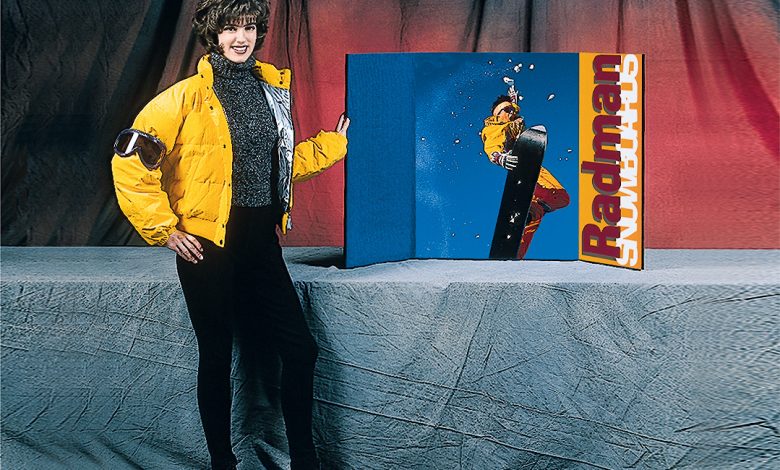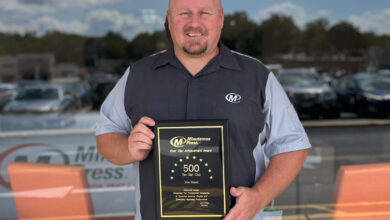The tabletop display industry has evolved over time as technologies have improved. Displays have become more compact and more versatile as companies have moved away from tri-fold, science fair-type boards to compact versions of manufacturers’ most popular full-size display options.
Trade shows, job fairs, corporate settings, college recruiting events and retailers have embraced tabletop displays. From printed table coverings to frames made out of tubing or retractable metal banner stands, the options are endless.
Tom Carter, president and product designer at EXPOGO Displays & Graphics, Inc. in Wilmington, North Carolina, has been in the business since 1988. He says that everyone is looking for lightweight and portable display options, which is a far cry from the folding panel systems of the past. When everyone else was producing folding panel displays with one color on the front and another on the back, EXPOGO’s version included an arched top and inlaid stripes to make it stand out from the competition.
About 15 years ago, EXPOGO’s ShowStyle briefcase display became popular. The entire display is contained in a briefcase and the briefcase itself becomes a part of the foldable display, even the arched top. The briefcase handle retracts and becomes flush with the edge of the display.
“All the graphics remained attached to it when you opened it. It was a new type of system,” says Carter.
EXPOGO has developed a larger version of the ShowStyle, called the ShowStyle Pro 32, which offers 14 square feet of graphic display area, an arched header and lighting.
The biggest thing in tabletop displays currently is fabric, Carter says. Companies are offering pole stands, pop-up tabletops, tension tabletops and ones that have extrusions made from aluminum.
Its newest option is called the ShowFlex, a display that opens like an umbrella and is easy to set up in a few seconds, he says.
“There’s nothing else like it on the market. It is a huge hit,” Carter says. The display comes in a padded travel bag and can be as small as 28 inches or as wide as 92 inches to fill an 8-foot tabletop.
“That’s a new direction for tabletops because they are extremely lightweight and easy to set up,” Carter says.
Pharmaceutical companies are very interested in the ShowFlex because their reps travel to various medical centers and doctors’ offices to educate them about new drugs that are available on the market.
“Our niche is to innovate and do things that haven’t been done before. That’s really what we focus on,” Carter says.
Some events have height restrictions so many clients want small tabletop displays so people can see over them when they are sitting at the table. Pop-ups are popular because once the frame is set up, it is simple to attach fabric panels to the frame. They also can be exchanged for new graphics fairly easily, he says.
Tension fabric systems are also gaining in popularity, but you have to put them together, he says. Once the frame is together, a pillow case graphic is slid over the frame. It can take 10 to 15 minutes to put one of these displays together.
Kent Dunham, vice president of sales for Creative Banner Displays in Brooklyn Center, Minnesota, says that his company is the largest table throw manufacturer in North America. It offers two different styles of throw, thermal imprint, where a basic logo is imprinted on the front of a stock table cover, or custom table throws, where dye sublimation is used to do an edge-to-edge design on the table covering.
Many events offer basic table cloths in black or white at their event locations.
“This is an inexpensive way to get some corporate identity with a table throw,” he says.
His company offers table runners along with full table coverings. It also uses some unique fabrics, like aluminum fabric which looks metallic, and Glam Dot, which features shiny metallic dots that give it a holographic appearance. When you print over it, it adds depth and light to anything printed on it, Dunham says.
High tech and beverage companies are particularly attracted to the metallic fabric because they can make the throw look like a can of beer or soda and print condensation marks next to the logo.
“We like to call table throws the gateway drug to displays,” Dunham says with a laugh. “Once you do that, then you can build from there.”
If an exhibitor plans to sit behind the table, the company makes three-sided table throws. There’s also a stretch option called UltraFit, where the fabric grabs onto the table legs offering a tight-fitted look. The throws can also be stain resistant and can fit round tables and 6-foot and 8-foot long rectangular tables.
Creative Banner Displays has been doing table throws for 15 years. It also offers tri-fold panel systems that can either display graphics or can replace a graphic with a dry erase board for presentation purposes.
All of its tabletop systems are designed so that one person can easily set them up, Dunham says.
Its Micro GeoMetrix kits include lightweight aluminum frames with plastic hubs that can hold dye sublimated graphics printed on polyester double knit fabric. The kits come in various sizes and shapes and are stored in a carrying case. The company also added shelves that attach to the aluminum frame in response to companies that wanted to be able to display products on their tables. It also sells tabletop banner displays and micro sail signs.
Creative Banner Displays also offers what it calls Over the Top tabletop displays, which clamp onto the edge of the table and make a display table look like a full booth.
Orbus Exhibit & Display Group has turned its popular banner stands and extension formula master lines into tabletop versions.
“We are seeing a lot of growth in that area,” says Kyle McDonald, marketing coordinator for Orbus Exhibit & Display Group.
He adds that Orbus saw steady growth from 2015 to 2017 with its Formulate tubing frames covered with a graphic. Most of its tabletop products saw big jumps in the past year.
“We’ve had a lot of positive feedback on our tabletop versions, which would be full-size products,” he says.
Most trade show displays include technology these days, so clients are looking for displays they can set up around their computers or virtual reality headsets that don’t take up that much space.
“It can be related to each company’s brand. It is easy to put a quick message on a small area that can then be expanded via technology or conversation. It brings people in without taking up too much real estate,” says Amy Benes, marketing manager for Orbus Exhibit & Display Group.
Colleges are using virtual reality headsets to give prospective students virtual tours of their campuses and other clients are integrating gaming systems or tablet computers to collect lead information and hook people into their tabletop displays, Benes says.
Tabletop displays are cheaper to purchase than full-size displays. They take up a fraction of the space and a fraction of the manpower needed to set them up.
“In general, you’re paying for less product. You are paying less money than you would for a full-size display. As with large displays, it depends on what you want to get,” McDonald says.
Orbus’ Breeze and Breeze 2 retractable banner stands are very popular. The graphic pulls up out of a cassette and is held in place by a pole. It takes seconds to set up and a client can use more than one in its display, he says.
The graphics are printed on fabric or vinyl.
Back 20 or 30 years ago, nobody had access to computers, movies or televisions in their tabletop displays. They didn’t have the video or production capabilities. You had to detail it out on the display, which meant a lot of text and a lot of laminated pages Velcro’d to a tri-fold display, says Benes.
“Now, displays attract people with wide graphic images and use supplemental sales tools to communicate what the capabilities and products are for a particular vendor,” she says.
She agrees that fabric is really huge right now in tabletop displays. Many tabletop displays are moving toward silicon edge graphics, where the edged fabrics can be slid into a frame for easy setup. Orbus is also seeing a lot of interest in magnetized banner stands. The company is taking full size displays and shrinking them down for tabletop applications.
“I think anywhere there is business you will see these popping up. They work better than a large display would. They can be moved to fit any configuration. I think anywhere there was a large banner stand or a big stand you could see smaller displays being placed,” says McDonald.
Becky Hines, marketing director for Alpina Manufacturing in Chicago, says that her company’s customers order tabletops for retail stores, hotel lobbies and in the foyers of condominium buildings.
“They are also a great option in large, open spaces where important ads or messages need to be relayed and a wall frame simply isn’t an option, for example, in a convention hall,” she says.
Alpina makes flip-up frames in may profiles and colors, slide-in frames, banner grips, Cloudlight LED frames, fabric SEG frames, banner clips and floor stands.
“We really don’t get many requests to make tabletops, probably because we are known for making larger frames and banners, but we do make our frames as small as 5″ x 5″,” Hines says.





